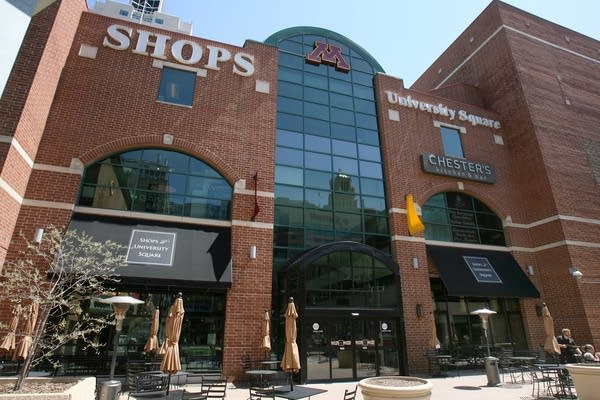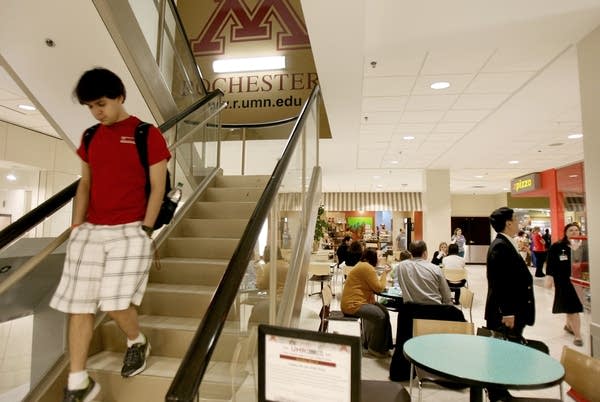Founding class of UMN-Rochester students set to graduate

Go Deeper.
Create an account or log in to save stories.
Like this?
Thanks for liking this story! We have added it to a list of your favorite stories.

When the first graduates of the University of Minnesota-Rochester receive their diplomas Saturday, they'll leave a campus that's still figuring things out.
Instructors are still experimenting with the curriculum and how best to teach it.
Students are still trying to build a social life and an identity within the city.
And every once in a while, outsiders still wander onto the main floor, scratch their heads and ask:
Turn Up Your Support
MPR News helps you turn down the noise and build shared understanding. Turn up your support for this public resource and keep trusted journalism accessible to all.
Hey -- where's the food court?
But that's to be expected, considering that the school -- an educational experiment that started up in a shopping mall, of all places -- is only four years old.
"We're in adolescence," said biology professor Robert Dunbar, one of the original faculty members. "We're not mature yet."
For decades, the city of Rochester acted as a satellite location for various University of Minnesota programs. Its dreams for a higher education institution were realized in 2005 when Gov. Tim Pawlenty proposed a full-fledged campus to fill what he saw as a significant educational gap in southeastern Minnesota.
In the fall of 2009, 57 students began their first classes at what became known as "UMR." They were hailed as "trailblazers" and "risk takers" who gave up the traditional college experience at an established university for a chance to create their own.

They had no real campus -- just a couple of floors in the old Galleria Mall where the movie theater and food court used to be.
"One of the classrooms used to smell like fish oil," said biology professor Andrew Petzold. "Apparently it used to share a drain with what used to be a Long John Silver's."
They had no dorms, so students lived in a nearby apartment building. They had no athletic facility, so the university gave students memberships to the YMCA. And they had no cafeteria, leaving students to eat in downtown food joints or bring their lunch to school.
And with no intercollegiate sports, fraternities or clubs, it was up to students to make their own student life.
That rather spartan existence, combined with an specialized health-care curriculum that students call "intense," has drawn a student body that's focused on academics. Many have their sights on medical school or graduate work in the medical field.
"They just seem driven compared to students at some other campuses." said sophomore Yusef Ouda of Rochester.
UMR has gained a bit of national attention for its unusual approach to education. The Chronicle of Higher Education noted how it was "scrapping the traditional university model," and Washington Monthly called it the "Mayo Clinic of Higher Ed."
Several things stand out about the university.

A specialized education
UMR offers only two health-related bachelor's degrees, as well a master's and a doctoral degree in biomedical informatics and computational biology. It plays up its proximity to the world-famous Mayo Clinic, and students in one UMR degree program take classes from Mayo School of Health Sciences faculty and use Mayo facilities.
An encouragement of teaching
UMR eschews the "publish-or-perish" research-oriented culture of many universities. You won't find large, anonymous lectures here. The campus does have one lecture hall -- but it's used only for community events. Students say they've enjoyed the relatively small class sizes. Most are between half a dozen students and about 30.
And students say they enjoy spending time at an innovation at UMR: the Just Ask Centers. These are open, common study areas where UMR faculty spend up to 22 hours a week helping students, answering questions and holding "extended office hours."

"It's one of the main reasons I came here." said sophomore Kaylin Hibbing of Woodbury. "For five minutes or an hour, they'll sit there and work with you. I was actually studying for pretty much my entire organic chemistry final at the center last year. I just got to sit with the professor (with a few other people) and worked through problems."
Integrated classes
UMR has no academic departments. Instead, instructors from various subjects integrate their classes to provide an almost holistic approach to teaching. Many classes and student papers attack a subject from multiple disciplines. For example, students might learn in biology about the science behind organ transplants and in ethics about the issue of organ trafficking.
Faculty also strive to make subjects relevant. Take math, for example. Pre-med junior Luke Bennett of Austin said a calculus lesson taught him how much time it takes medication to make its way through the human body.
"In a lot of calculus classes, you focus only on the math aspect," he said. "Of course we do that, but then we move on to the (health field) application."
But UMR has had some growing pains.

Integrating classes isn't difficult in the first couple of years when students have to take the same courses. But professors say it has become more difficult to coordinate them as students take a wider array of subjects.
Course expectations have also been in flux. To encourage students to be creative, professors sometimes make assignments open-ended. But sometimes instructors are ambiguous because they're still getting a feel for what to expect from students. Petzold says that's all part of building a curriculum. Some students love the freedom in such classes, he says, but others can't stand it.
Senior Laura Traut of Sartell is conflicted about it.
"I really like direction so I know what's expected of me -- what (faculty) want for an outcome in a group project or individual project," she said. "They'll say we want a paper on X topic. And you ask, 'What aspect? How long?' And they say it doesn't matter. It's a little bit frustrating, because you don't know what to do."
That said, she has come to appreciate the ability to handle ambiguity -- a real-world skill.
The relationship with Mayo -- which the school plays up, and which draws a lot of UMR's students -- is also a bit ambiguous to some on campus. Students love rubbing shoulders with Mayo personnel while getting lunch in the sandwich shop downstairs. And in their four years, they've heard from Mayo guest speakers, volunteered at the clinic or done job shadowing.

But some said they're not sure what the real payoff will be. UMR has no formal feeder program with Mayo such as one might find with companies at established universities, students and faculty say.
Chancellor Stephen Lehmkuhle said UMR's proximity to Mayo means the doors are "cracked open for them," but students have to "walk in."
For that matter, UMR doesn't have a formal career center for jobs or internships. Instead, students consult faculty or UMR's "student success coaches" when they're looking for opportunities. UMR spokeswoman Sarah Oslund says that method allows the coaches to better understand students and their needs.
Student life is also less structured. UMR now sports 30 clubs, but students say they have to work a bit to find the usual college fun. Although downtown is beginning to cater to students, it still doesn't boast the kind of atmosphere found around many traditional campuses.
"We'd like a coffee shop that's open past 5 p.m.," said senior Tanner VanLith. "You go down to the subway level, and everything is closed up."
That's beginning to change, he said.

But then again, no one is really groaning about social life. Bennett said a lot of his classmates are too focused on their education and volunteering to be bothered. Those who couldn't take the lack of social life have gone elsewhere.
One peeve of students is that a lot of Rochester residents still don't really know what UMR is -- or think it's Rochester Community and Technical College.
Students say they'd like to be able to tell locals, "I go to the U," and be understood that it's UMR.
So if Rochester's own residents don't fully recognize their own college yet, what awaits graduates when they apply for jobs and graduate school? How will recruiters view a program and campus that have no real track record?
"To be honest," Lehmkuhle said, "I think some of our students will be handicapped. We just don't have (an established) reputation. But I really think that's short-lived. Our students -- if they can get an interview, just get their foot in the door, they will impress people."
Professors at two U.S. universities agreed.
They said the reputation of a school and its faculty does indeed count. And a school with a small faculty has a smaller network of contacts -- and may offer fewer academic experiences than a large, established program does.
But smaller programs also enable faculty to really know their students.

"It very much matters what (faculty) say about the individual student, and how they characterize their experience and their relationship with the student -- what they tell us about the potential of that student," said Professor Amy Schulz, who has chaired the doctoral admissions committee for the University of Michigan's department of health behavior.
John Hoffman, who helped start a doctorate of education program at California State University - Fullerton, says students should stress to recruiters that they learned about having "an entrepreneurial eye, an innovative mindset, being able to make adjustments as needed on the job as things are or aren't working."
"Those," he said, "are certainly be things that I would find compelling."
All that is now on the radar of 31 students -- the share of the original 57 who are either graduating this month or are close to doing so. The vast majority of the rest have left the health-care path, Oslund said.
The school has not formally tracked graduates' plans or job placement. Oslund said some have secured jobs in healthcare, while others are applying to medical school, chiropractic school or graduate school in areas such as healthcare administration. Several have already been accepted, she said.
Meanwhile, UMR continues to expand.
It's now almost three times the size it was when it opened. UMR's original student body of 57 has ballooned to 407 undergraduates and 37 graduate students, and officials hope that number grows to 5,000 students in the next two decades.
Although UMR still leases all its space, it plans to build a five-square-block campus several blocks from its current location. Oslund said it could take three decades before the campus is fully developed, but has no plan to move out of its current location.
All that growth may challenge professors such as Dunbar, who relishes the creativity and freedom that a new program allows.
"In some ways, I look forward to our becoming mature," he said. "But in other ways I dread it. I don't think that we should become mature. I think perpetual adolescence might be good for UMR. It might be good for other institutions as well."



